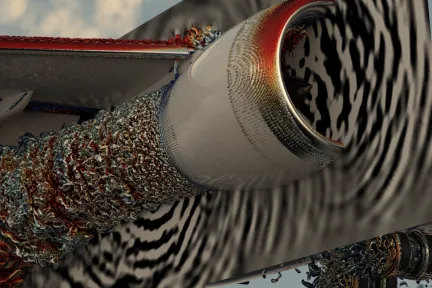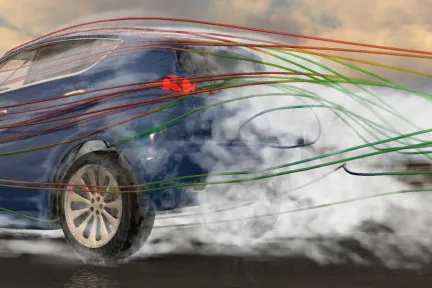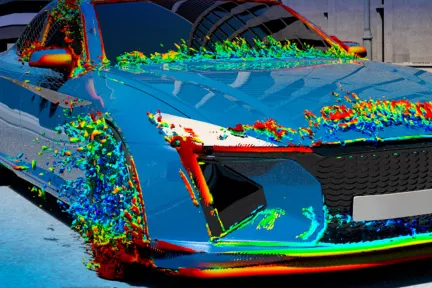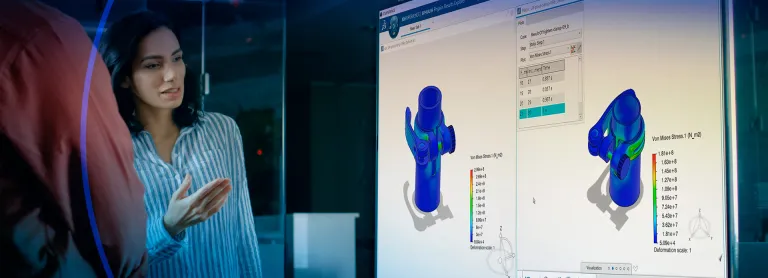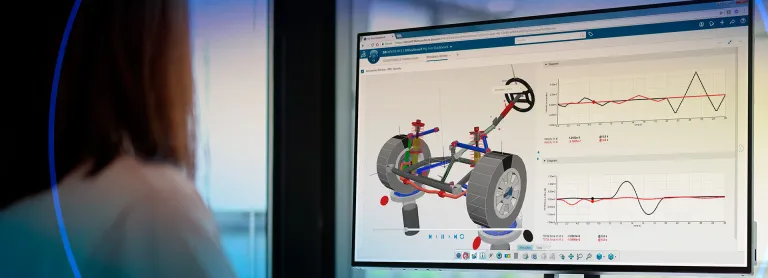Computational Fluid Dynamics Simulation
Steady-State and Transient Internal and External Flow Around and Through Solids and Structures
Fast, High-Fidelity CFD Simulation
SIMULIA's Computational Fluid Dynamics (CFD) simulations enable customers to engineer products with precise real-world performance predictions delivered quickly. Our Fluids technologies address diverse challenges across industries and applications, such as eVTOL flight and community noise testing, race-car aerodynamics optimization, and automotive WLTP fuel efficiency certification.
SIMULIA Fluids Simulation is driven by two complementary technologies that provide customers with scalable fluid simulation to address a broad range of real-world applications. PowerFLOW and XFlow offer world-class Lattice Boltzmann method (LBM) technology for high-fidelity simulations that accurately predict real-world performance. Fluid Dynamics Engineer enables multi-scale multi-physical insight by embedding CFD into design, simulation, optimization, data management, and business intelligence applications within the 3DEXPERIENCE platform. In addition, a Plastics Injection Molding application allows validation and optimization of plastic part and mold tooling designs early in the product development process.
SIMULIA Computational Fluid Dynamics Simulation Key Benefits
Faster design turnaround times
Simulation accelerates analysis and optimization, allowing shorter design cycles and providing a competitive advantage
Reduced reliance on testing
Compared to wind tunnel testing, simulation is faster, more cost-effective and can be implemented earlier in the design cycle. It can also reveal behavior not visible in a test
Versatile, high-performance simulation technology
Aerodynamic and aeroacoustic simulation can be performed on large, complex structures and in real-world conditions
Reduced work through automation
Automatic meshing, model-building, visualization and Design of Experiments (DoE) removes tedious set-up work and lets engineers get the results they need faster
Leverage design models
Unified modeling and simulation (MODSIM) means simulation can be performed directly on geometry from CATIA or SOLIDWORKS in a unified design environment, reducing the time needed for model building.
Full analysis with multiphysics simulation
Fluids simulation can be supplemented by other disciplines, such as vibro-acoustic simulation, structures simulation, electromagnetic simulation and multibody system simulation
SIMULIA Fluids Solver Technology
- Navier-Stokes
- Lattice Boltzmann
Navier-Stokes
The physical space to be simulated is divided into many small subdomains called control volumes or cells. The finite volume method is used to discretize the continuum equations that describe fluid motion, known as the Navier-Stokes equations. The resulting set of algebraic equations is solved iteratively to obtain the pressure, velocity, temperature (and other physical quantities) in each cell for steady or unsteady flows. Other discretized transport equations can be solved in the same way to represent other physical phenomena like turbulence and chemical species.
Lattice Boltzmann
Based on a discrete form of the kinetic theory of gases, the Lattice Boltzmann method tracks the microscopic motion of fluid particles through discrete space and time, to simulate the flow of gases and liquids. The fluid space is automatically discretized into cubic voxels, and boundaries into surfels, eliminating the need for conventional surface and volume grid generation. The Very Large Eddy Scale (VLES) turbulence modeling approach ensures that anisotropic fluid structures are captured with high fidelity, which is critical for aerodynamics and aeroacoustics workflows.
Discover the CFD Sub-disciplines
SIMULIA Computational Fluid Dynamics Simulation Software Products
SIMULIA Computational Fluid Dynamics Software on 3DEXPERIENCE Platform
SIMULIA Computational Fluid Dynamics Simulation software products are packaged as Roles on the 3DEXPERIENCE platform to get you up to speed faster and work more efficiently with all needed applications available at your fingertips. Select a package that corresponds to your role in an organization.
Start Your Journey
Explore the technological advancements, innovative methodologies, and evolving industry demands that are reshaping the world of Fluids & Computational Fluid Dynamics. Stay a step ahead with SIMULIA. Discover now.
FAQs About Computational Fluid Dynamics Simulation
Also Discover
Learn What SIMULIA Can Do for You
Speak with a SIMULIA expert to learn how our solutions enable seamless collaboration and sustainable innovation at organizations of every size.
Get Started
Courses and classes are available for students, academia, professionals and companies. Find the right SIMULIA training for you.
Get Help
Find information on software & hardware certification, software downloads, user documentation, support contact and services offering

